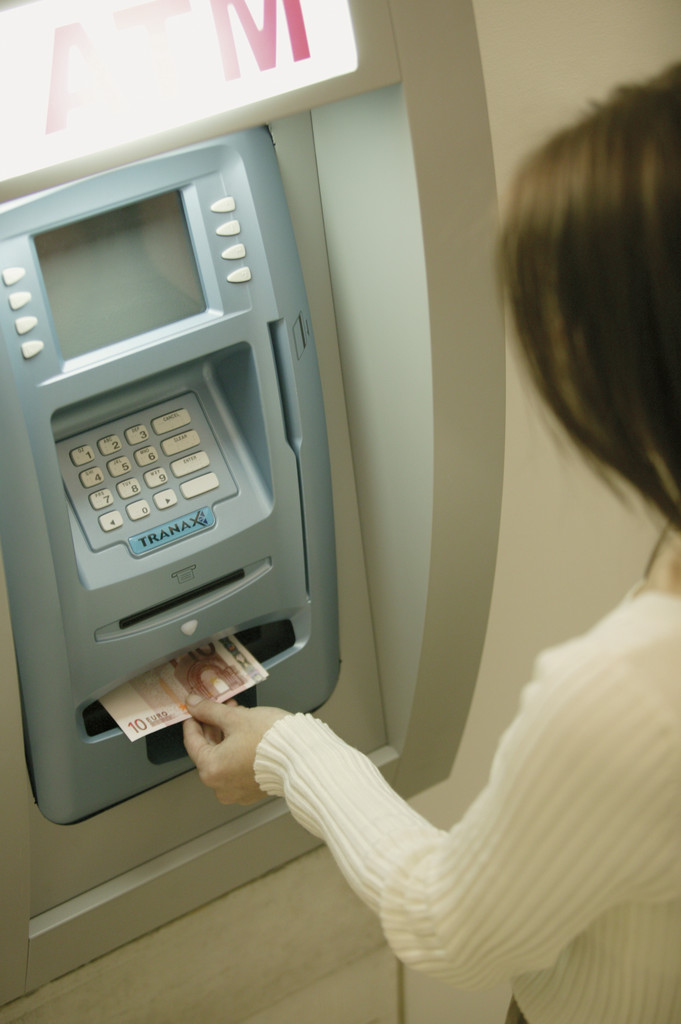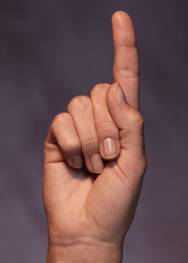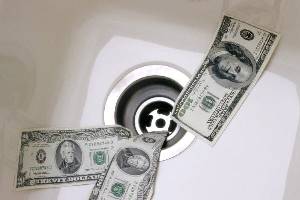Impulsive Spending - Or How Not To Spend Money
Impulse spending is just what it sounds like: buying goods and services on impulse, because they caught your attention, because it seems like a a great deal, or just to make yourself feel better.
When you are in a store and actively shopping, impulse buying can be difficult to resist. I know that often I come home from the grocery store with at least one impulse item, despite the carefully written list that I brought to the store. While that list does give me a boost of discipline, the stray item that "looks so good!" or "is on a really, really good sale!" will find it's way into my cart.
A May 2011 survey of more than 2,000 customers by the British energy company npower, had some surprising findings. Their survey revealed that more than a third of the respondents make an impulse purchase at least once a week. Those spur-of-the-moment purchases add up, too. Men reported spending the US dollar equivalent of about $41.38 (21.24 GBP) weekly, while women showed more restraint with reported spending of $30.45 (18.89 GBP). Yes, in this survey, men are impulsively spending more than women.
Even more disturbing is how those dollars add up. Men are thoughtlessly spending $2151.76 per year while women fritter away $1583.40. Theoretically, that would mean that a couple would impulsively spend $3735.16 a year.
Now think of that couple's cumulative sum after 10 years ... $37,351.60. After 20 years ... $74,703.20. That is a lot of money.
Certainly not every dollar spent impulsively is wasted money. The occasional impulse purchase can be considered fun money spent or simply recreational spending. The key word here is "occasional". Regular impulse spending can make a ruin of your financial dreams.
Here are the 20 most purchased items in the npower survey:
TOP 20 ‘IMPULSE BUYS’ ACCORDING TO nPower SURVEY
1. Food
2. Clothing
3. Magazines
4. Bottles of wine
5. Books
6. DVDs
7. Shoes
8. Holidays
9. Beer
10. Toiletries
11. Home furnishings
12. Music
13. Clothes for the children
14. Jewelery
15. Accessories
16. Gadgets
17. Garden accessories
18. Flowers
19. Toys
20. Day trips
Reading the list makes me wonder how much of the purchases were simply wasted dollars and how many were satisfying purchases with lasting effects.
Impulsive Spending - How to Control It
For many individuals, learning to stop or cut back on impulse spending can be the single most powerful way to change their financial situation. Here are The Fat Dollar's suggestions for getting your spending under control. There are a lot of suggestions here. I don't recommend that you try them all at once. Read through the list and pick one or two that seems to resonate. Try those, make them a habit if they work for you, and then move on to learn one or two more. Impulsive spending will soon be under your control.
- First, determine how much you are spending on impulse purchases:

- Connect the spending to a specific dream purchase
Keeping the yearly impulse spending figure in mind, think of one of your financial dreams that closely matches the yearly, the five year, or ten year amount. For example, if you have dreamed of having a French door refrigerator, but just don't seem to have the $2500.00 purchase price, then use this as your motivation. Whenever you are tempted to make an impulse purchase, think of the refrigerator in as much detail as you can. Be as specific as possible. Find an ad with a photo of the refrigerator and paste it on an index card and put it in your purse or wallet. Use that thought or photo to help you to resist the impulse purchase.
If you and your spouse are making impulse purchases of $71.83 a week (as in the study from npower) and you both agree to cut back $53.87 (75%) of that spending and put it in a savings account instead, then in about eleven months you would have enough money to purchase your refrigerator. Cool, huh? (pun intended)
- Use the 20 second rule
In his book, The Happiness Advantage, Harvard professor Shawn Anchor explains a personal discovery that he made that helped him to change an unwanted behavior. He found that if he could create a delay - as short as 20 seconds - in fulfilling the behavior, then he usually found it too much trouble to complete the unwanted behavior.
In Shawn Anchor's example, he wanted to stop wasting his time watching TV. His unwanted behavior was to come home from work, plop on the couch and automatically click the remote to turn on the TV where he would remain watching for hours. He found the 20 second solution by putting the remote in a drawer across the room. In order to turn on the TV he would have to get up, walk across the room, open the drawer, return with the remote and then click on the TV. That 20 second delay changed his evening life. Instead of watching TV, he wrote a book.
For our purposes, here are some suggestions to use the 20 second rule:
- Limit the amount of cash that you carry and have readily available. For example, allocate $20.00 from each paycheck as money to keep in your wallet. Deposit the rest in your bank account.
- Make it difficult to get to your credit cards and bank debit cards. You could go to extremes and cut the cards up or freeze them whole in an ice cube in the freezer, but let's be more realistic. Try wrapping the card(s) in paper, taping it up with lots of tape and placing the bundle in a zippered pocket of your purse. Unzipping the pocket, rummaging for the bundle, then opening it should create at least a 20 second delay and will be enough that you will usually find it too much trouble to bother with for an impulse purchase.
- Give yourself something that you must do before you can spend impulsively. For example, you may assign yourself the task of singing the happy birthday song two times (under your breath, of course) before you can get the credit card or cash out. You can even combine the dream purchase method and the 20 second method and require yourself to study the picture of your dream purchase (a French door refrigerator in our example) for at least 20 seconds before you can touch the credit card or wallet.
- If online shopping is a problem, then first identify your favorite spending sites. Remove the spending site links from your favorites or bookmarks. If you must keep them in your bookmarks list, then set up your bookmarks with subcategories so that you have to click 5 - 10 links deep in the menus to get to the link.
- Don't allow your browser to "remember" the username and passwords to your favorite online shopping sites. Make the password complicated enough that you have to type a lot of mixed characters and/or look up the password every time you want to use the site.
- If you are easily influenced by the ads on your browser's home page, then use your internet tools option to change the home page to something plain like google.com or a web site that has no product advertising on their home page.
- Don't allow your favorite sites to save your credit card information. If you have to get up, get your purse or wallet, pull out the credit card and key in the numbers, you may find the 20 or more second delay means the purchase will be too much work.
- Stop Using the ATM Machine

Also try some of the 20-second methods above, such as wrapping and taping the ATM card in a paper bundle, or making yourself drive around the block before you can turn into the ATM machine drive. You could also carry your checking account register and make a new habit of writing down the ATM withdrawal and calculating your new balance before you can actually make the cash withdrawal. Anything that causes it to be extra steps before you can use the ATM machine should be very helpful in causing you to want to make fewer withdrawals.
- Make a List
Having a list will help you to develop the discipline of buying only what you intended to buy. This becomes even more powerful as you develop the skill and habit of organization so that you always keep the list current. If you are running low on ketchup, for example, it gets put immediately on the list. As your confidence in the list increases, you know that if an item is not on the list, you probably don't need it.
Developing this habit of organization gives the list method extra power because not only does the list help you to buy only the specific, planned items, but it also helps to prevent you from buying something because you "might" need it.
Another, more subtle, benefit of making a list is that sometimes you may just have the urge to go to a store and buy something. You simply want that change of pace or perhaps you want that sense of satisfaction from having something shiny and new to take home. If you have a continually updated list, then you can fulfill that restless urge by going to the store with purpose and buying useful, needed, planned items. It's certainly better to figure out how to quash the urge to buy new things, but while you are learning, the list method can help you to avoid impulsive spending.
Keep the list in a central place, like the refrigerator, or a shared file on the family computer, so that it's easy to update and easy to get to when it's time for shopping. It's even better if you can keep the list or a copy of the list on your smart phone so that when you have the overwhelming urge to buy something, you've got your list right there.
- Find a Substitute for the Spending
Let's face it, much of our impulse spending is just a way to get that shot of pleasurable dopamine that is released when we make an impulsive purchase. If you want to cut back on the spending, then train yourself to find other ways to feel better.

Getting a massage is another way to release dopamine, as well as hugging, and other ... uhm, activities that increase skin to skin contact.
Think of your own interests and develop a hobby, such as digital photography, baking, visiting local parks, writing poetry, growing flowers, or researching your family genealogy.
Take a class, online or in the classroom, on something that interests you, such as learning a new language.
Do things for other people. Instead of surfing stores online or going shopping, use the time to help an elderly friend make a repair to their home, take your kids to the playground, sit and talk with your spouse on the back deck, or volunteer for your church or local charity.
The secret is to find something else that makes you feel good and train yourself into the habit of doing that instead of feeling good by spending.
- Stay Out of the Stores
This could be the most powerful suggestion of all. It is the one that I use to control most of my impulse spending. My weakest spending point is at our local Sam's Club. The prices are so good on many of their clearance and special purchase items that I usually leave the store with several unplanned items in my cart. Each time I shop there, I resolve to get only the things on my list, but find that I make a lot of excuses to myself once I'm actually shopping. I finally changed the amount of impulse spending by limiting my Sam's Club shopping trips to once a month. I was amazed at how much spending I cut from my budget. I make a note of the date of the shopping trip, plan my purchases to last at least a month (not hard with the super sized packages at Sam's Club) and then wait at least 30 days to go back. Not only did it greatly reduce impulse spending, but it also made me more organized and aware of how much of each product I was actually using.
If you must go to the store, you can also limit yourself to certain aisles of the stores. For example, you may resolve to not even roll the cart down the candy aisle, magazine aisle, or the beauty products aisle at the grocery store. When you go to the check-out, choose the lane that has the least amount of tempting items on display.
- Keep Track of Your Impulse Spending
In addition to initially finding out how much you spend on impulse, make it a habit to keep track of your spending. Just knowing that you will have to be accountable for the purchase is often enough to make you reconsider whether it is worth it. Requiring yourself to write down each purchase, or to save all the receipts in an envelope for review, may also be enough to make it too much trouble to make a purchase.
- Find the One Thing and Control It

Once you've identified just one main problematic spending item, then concentrate on controlling only that. If magazines are your problem, then give yourself some guidelines, such as no new magazines until you've completely read the last magazine you purchased, or you may just avoid the magazine racks, or limit the number of magazines you can purchase in a week or month. You may choose to select only certain titles of magazines. Use whatever works for you to actually bring the magazine buying under your complete control.
After you have conquered the impulse spending on the one main item then identify the next "one thing" and work just on it. Give yourself at least a month of having each spending problem under control before you move on to the next one.
You may be surprised to find that you have only one or two areas where impulsive spending is out of control. Once you have eliminated those problem areas, you just may find that you no longer have an impulsive spending problem.
- Compare Three
How many times have you stumbled upon a sale item that seems like it must be a good bargain, so you buy it immediately. However, once you get the item home and use it, you discover that the item was an inferior model, or discontinued, not something fitted to your personal needs, or maybe that the price was not nearly as good as it seemed in the store.
You will prevent most of this type of wasteful impulsive spending if you develop the habit of comparing the price and features of at least three different brands and then once you pick the brand, compare prices from three different stores. Using online searches and making phone calls to stores can make this entire process take just a few minutes.
One other step that I usually take is to compare customer reviews for the item in question. My favorite place to look is to search for the item on amazon.com and read the reviews.
To effectively use the "compare three" method, pick a dollar amount, and use the method for any purchase above that amount. For example, you may determine that you will compare prices and features for any purchase above $45.00.
- Buy Only What You Can Pay For Today

If you don't have the cash to pay for something, then don't buy it.
You should have the money either in cash or your checking account to fully pay for the item before you buy it. This means that you either pay cash, or if you paid by credit card, you go home and immediately make a payment to your credit card company to cover the purchase. If you can't do either one, then you most likely can't afford the purchase. Don't buy it.
- Use Positive Rewards
In general, we respond better when we work toward something positive, instead of trying to avoid something negative. Try making a game out of reducing your impulse shopping. Each time you are successful in keeping within your spending limits, then give yourself a reward, such as reading a chapter of a novel, or giving yourself an at-home beauty treatment, watching a movie, or even just writing down in a notebook a few lines of praise for yourself for hitting your goal. Remember the star chart that your teacher kept in first grade? You probably worked pretty hard to get your teacher to paste a gold star after your name. Recognition of our accomplishments can be a pretty powerful motivator.
- Give Yourself a Bit of Mad Money
One especially troublesome human trait is that we tend to rebel against being told that something is forbidden. Whether it's because we don't like being controlled, or because we simply like forbidden things, we tend to do much better with change if the change is of our own free will or power.
With this in mind, give yourself a small, easily affordable, regular sum of money that you can use for spending on whatever you choose.
If you try to cut your impulse spending down to complete zero, you may find that you feel so deprived or resentful that you become obsessed with spending. While developing a new spending habit may be uncomfortable and even inconvenient, it should not be agonizing or make you feel that all your pleasures in life have disappeared. Having some freedom with spending will give you back your sense of control. Remind yourself that you certainly could buy that shiny gadget, but you are choosing not to.
Hopefully, one or more of these suggestions will have you well on your way to your financial goals and with your spending well under your control. Have fun with learning these new spending habits. After all, saving money while having fun is The Fat Dollar way.
Article by Patti Tokar Canton
© 2011- 2019 All Rights Reserved. Do Not Duplicate Without PermissionRECOMMENDED BOOK

Your Money or Your Life by Joe Dominguez and Vickie Robin
9 Steps to Transforming Your Relationship With Money and Achieving Financial Independence.
Are you working to make a living or working to make a life? Change the way you treat money and think about money. Revolutionary, inspiring and empowering nine-step program for transforming your relationship with money and achieving financial independence. This book is a classic and has changed many lives and Amazon readers give it a 4+ star rating (out of 5)!
 THE COMPLETE TIGHTWAD GAZETTE by Amy Dacyczyn
THE COMPLETE TIGHTWAD GAZETTE by Amy Dacyczyn
....This is one of my favorite books.
Although a little quirky sometimes, and sometimes a little extreme, this book has many great ideas for spending less on low priority stuff so you'll have more money to spend on high priority stuff (like college, or a house!) The author, Amy Dacyczyn lived her dream of having a large farm house and many happy kids all while working from home and learning how to be creative and frugal. Amy's background in graphic design makes her approach to saving money simply delightful. The best part for me was the wonderful tone of family love that weaves throughout the book. Very creative and fun book and VERY THICK! You will definitely get your money's worth in simple living tips and money saving tips with this book.
Books are offered in association with Amazon
The Fat Dollar Ideas
In the Kitchen - grocery shopping, cooking, planning ... get some Fat Dollar Ideas
Vitamins and Fruit Juice - save $63.87 a year and 20,440 calories
Recipes for Stale Marshmallows
In the Home - tips and ideas to save money in your home
Make Your Own Shampoo and Rinse - Herbal or Plain
Save Money on Anti-Aging and Skin Care Creams
Stop Comparing and Just Enjoy Your Life
Manage Your Money - Tips for managing your Fat Dollars
Save Money on Gas - Increase Your Mileage Up to 26%
Let Uncle Sam Help Finance Your Retirement Plan
Bartering Online or Offline - To fatten up your dollars
Fat Dollar recommends Simply Free Stuff site - Free samples and products
Books to help you save money and regain control of your Fat Dollars

